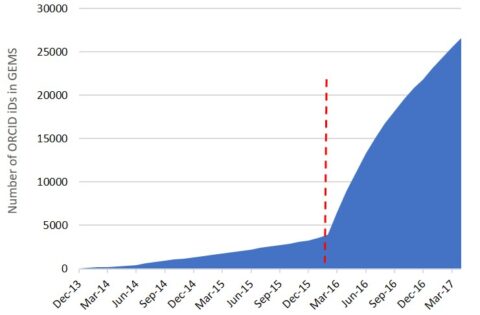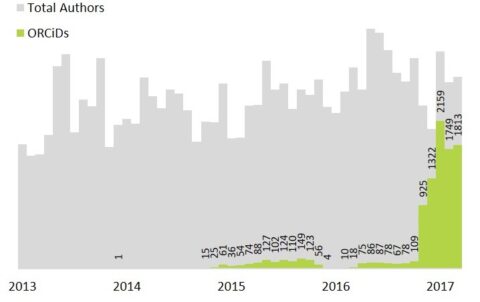Identifying people and reliably linking them with their research output has been a longstanding challenge. Until 2009 AGU primarily linked people and publications based on the spelling of a person’s name supplemented by email address and affiliation. But obviously names aren’t unique and can be written multiple ways, and email addresses and affiliations can change regularly. Enter ORCID, Open Researcher and Contributor ID, a unique identifier for researchers.
ORCID iDs allow people to verify their research output for organizations (publishers, funders, labs, etc.) and other individuals such as potential collaborators. Using the identifiers can reduce paperwork by preventing repeat data entry when applying for grants, registering for a meeting, or submitting a manuscript.

They also increase discovery of potential collaborators and scientific works by creating a digital network of people and their outputs and activities, which can foster international and interdisciplinary collaborations. They also allow researchers to gain credit for under-recognized activities such as peer reviews, presentations, datasets, blogs, patents, and book reviews.
Having first launced in 2009, ORCID adoption really started to grow in 2010. With increased promotion and education, and with the commitment of publishers, funders, granting bodies, and institutions, there are now over 3.7 million ORCID iDs for individuals and over 23 million works and activities connected to at least one iD. ORCID’s statistics page is always up-to-date with additional relevant data.
AGU Adopts and Adapts
AGU enabled ORCID in our peer review system, GEMS, at the end of 2013 but it wasn’t until 2016 that we, among other publishers, agreed to require corresponding authors to obtain and provide ORCID iDs. By increasing the number of iDs published with articles, the hope was to increase visibility of the initiative and encourage further researcher adoption, as well as showing the benefits.
In order to prepare for compliance with the agreement, AGU had to modify processes, communications, and systems. We started reaching out to authors in fall 2015 through a survey in partnership with ORCID followed by an article on Eos.org. We then updated template letters, login pages, and the manuscript submission form. We also sent authors reminder emails to link their ORCID iDs to their profile in GEMS.
It took a little longer to enable export of ORCID iDs along with other metadata about each article to our publishing partner, Wiley, but we started publishing them alongside author names at the end of 2016. Through Wiley and CrossRef, published articles can be added to an author’s ORCID account automatically, with authors managing this permission through their ORCID accounts.
Uptake and Growth

Adoption was high. Before we started making ORCID iDs mandatory for corresponding authors in March 2016 only a few hundred new iDs were added each month. But in March of 2016 there were 2594 ORCID iD additions, almost doubling the number of iDs in our system.
Since then, the number of ORCID iDs added has ranged from about 1000 to 2000 per month. As of August 2017, almost 30,000 GEMS accounts (about 11.5% of the total) had iDs.
Currently we highly encourage but do not require co-authors to have and connect an ORCID iD, but co-author adoption has also been high. In March 2016, for example, 71% of added iDs were to accounts of those acting as co-authors and/or reviewers.

With such an increase in authors connecting their ORCID iD to their GEMS profile, there was an attendant increase in the number of articles published with ORCID iDs. Currently about two-thirds of published papers have authors with ORCID iDs.
We also enabled reviewers to connect their reviewing activities to their ORCID record. To preserve anonymity, these record just the journal and year that each review was completed.
As of May 31, 2017, a total of 3455 reviews of AGU journals were posted to ORCID records, the third highest of all organizations currently using this functionality.
What’s Next?
We still have some work to do before all publishers, funding bodies, and researchers are using ORCID iDs.
This year, AGU is including them for lead authors of abstracts at the Fall Meeting and including them in our member accounts. This will allow better linking of abstracts to related journal content (see also the API challenge for the Fall Meeting).
We are also adapting the manuscript submission system for books to make it mandatory for book editors and the corresponding authors of chapters to have ORCID iDs and strongly encouraging it for co-authors, as per our journals.
The focused effort of AGU and other publishers and support of our author-reviewers has paved the way for a world in which ORCID’s vision can be realized: “where all who participate in research, scholarship, and innovation are uniquely identified and connected to their contributions across disciplines, borders, and time.” If you haven’t created an ORCID iD and linked it to your GEMS (and other relevant accounts), please consider doing it now.
—Paige Wooden, Senior Program Manager, Publications, American Geophysical Union; email: [email protected] ![]() orcid.org/0000-0001-5104-8440
orcid.org/0000-0001-5104-8440
Citation:
Wooden, P. (2017), Connecting people and papers, Eos, 98, https://doi.org/10.1029/2018EO081259. Published on 12 September 2017.
Text © 2017. The authors. CC BY-NC-ND 3.0
Except where otherwise noted, images are subject to copyright. Any reuse without express permission from the copyright owner is prohibited.

